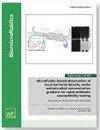Vascularized liver-on-a-chip model to investigate nicotine-induced dysfunction
IF 2.6
4区 工程技术
Q2 BIOCHEMICAL RESEARCH METHODS
引用次数: 0
Abstract
The development of physiologically relevant in vitro systems for simulating disease onset and progression and predicting drug metabolism holds tremendous value in reducing drug discovery time and cost. However, many of these platforms lack accuracy in replicating the tissue architecture and multicellular interactions. By leveraging three-dimensional cell culture, biomimetic soft hydrogels, and engineered stimuli, in vitro models have continued to progress. Nonetheless, the incorporation of the microvasculature has been met with many challenges, specifically with the addition of parenchymal cell types. Here, a systematic approach to investigating the initial seeding density of endothelial cells and its effects on interconnected networks was taken and combined with hepatic spheroids to form a liver-on-a-chip model. Leveraging this system, nicotine's effects on microvasculature and hepatic function were investigated. The findings indicated that nicotine led to interrupted adherens junctions, decreased guanosine triphosphate cyclohydrolase 1 expression, impaired angiogenesis, and lowered barrier function, all key factors in endothelial dysfunction. With the combination of the optimized microvascular networks, a vascularized liver-on-a-chip was formed, providing functional xenobiotic metabolism and synthesis of both albumin and urea. This system provides insight into potential hepatotoxicity caused by various drugs and allows for assessing vascular dysfunction in a high throughput manner.研究尼古丁诱导的功能障碍的血管化肝芯片模型
开发与生理相关的体外系统来模拟疾病的发生和发展以及预测药物代谢,在缩短药物研发时间和降低研发成本方面具有巨大价值。然而,许多此类平台在复制组织结构和多细胞相互作用方面缺乏准确性。通过利用三维细胞培养、仿生软水凝胶和工程刺激,体外模型在不断进步。然而,微血管的加入遇到了许多挑战,特别是在加入实质细胞类型时。在这里,我们采用了一种系统的方法来研究内皮细胞的初始播种密度及其对互连网络的影响,并将其与肝脏球体相结合,形成了肝脏芯片模型。利用这一系统,研究了尼古丁对微血管和肝功能的影响。研究结果表明,尼古丁会导致粘连连接中断、三磷酸鸟苷环醇酶1表达减少、血管生成受损和屏障功能降低,这些都是造成内皮功能障碍的关键因素。结合优化的微血管网络,形成了血管化的芯片肝脏,可进行功能性的异生物代谢并合成白蛋白和尿素。该系统有助于深入了解各种药物可能引起的肝脏毒性,并能以高通量方式评估血管功能障碍。
本文章由计算机程序翻译,如有差异,请以英文原文为准。
求助全文
约1分钟内获得全文
求助全文
来源期刊

Biomicrofluidics
生物-纳米科技
CiteScore
5.80
自引率
3.10%
发文量
68
审稿时长
1.3 months
期刊介绍:
Biomicrofluidics (BMF) is an online-only journal published by AIP Publishing to rapidly disseminate research in fundamental physicochemical mechanisms associated with microfluidic and nanofluidic phenomena. BMF also publishes research in unique microfluidic and nanofluidic techniques for diagnostic, medical, biological, pharmaceutical, environmental, and chemical applications.
BMF offers quick publication, multimedia capability, and worldwide circulation among academic, national, and industrial laboratories. With a primary focus on high-quality original research articles, BMF also organizes special sections that help explain and define specific challenges unique to the interdisciplinary field of biomicrofluidics.
Microfluidic and nanofluidic actuation (electrokinetics, acoustofluidics, optofluidics, capillary)
Liquid Biopsy (microRNA profiling, circulating tumor cell isolation, exosome isolation, circulating tumor DNA quantification)
Cell sorting, manipulation, and transfection (di/electrophoresis, magnetic beads, optical traps, electroporation)
Molecular Separation and Concentration (isotachophoresis, concentration polarization, di/electrophoresis, magnetic beads, nanoparticles)
Cell culture and analysis(single cell assays, stimuli response, stem cell transfection)
Genomic and proteomic analysis (rapid gene sequencing, DNA/protein/carbohydrate arrays)
Biosensors (immuno-assay, nucleic acid fluorescent assay, colorimetric assay, enzyme amplification, plasmonic and Raman nano-reporter, molecular beacon, FRET, aptamer, nanopore, optical fibers)
Biophysical transport and characterization (DNA, single protein, ion channel and membrane dynamics, cell motility and communication mechanisms, electrophysiology, patch clamping). Etc...
 求助内容:
求助内容: 应助结果提醒方式:
应助结果提醒方式:


